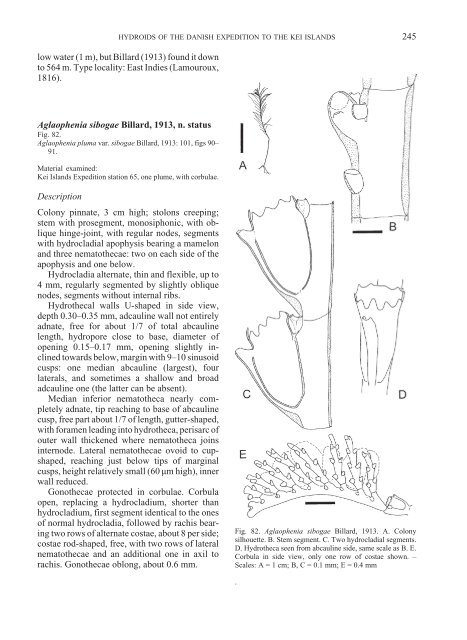Hydroids (Cnidaria, Hydrozoa) of the Danish expedition to
Hydroids (Cnidaria, Hydrozoa) of the Danish expedition to
Hydroids (Cnidaria, Hydrozoa) of the Danish expedition to
You also want an ePaper? Increase the reach of your titles
YUMPU automatically turns print PDFs into web optimized ePapers that Google loves.
HYDROIDS OF THE DANISH EXPEDITION TO THE KEI ISLANDS<br />
low water (1 m), but Billard (1913) found it down<br />
<strong>to</strong> 564 m. Type locality: East Indies (Lamouroux,<br />
1816).<br />
Aglaophenia sibogae Billard, 1913, n. status<br />
Fig. 82.<br />
Aglaophenia pluma var. sibogae Billard, 1913: 101, figs 90–<br />
91.<br />
Material examined:<br />
Kei Islands Expedition station 65, one plume, with corbulae.<br />
Description<br />
Colony pinnate, 3 cm high; s<strong>to</strong>lons creeping;<br />
stem with prosegment, monosiphonic, with oblique<br />
hinge-joint, with regular nodes, segments<br />
with hydrocladial apophysis bearing a mamelon<br />
and three nema<strong>to</strong><strong>the</strong>cae: two on each side <strong>of</strong> <strong>the</strong><br />
apophysis and one below.<br />
Hydrocladia alternate, thin and flexible, up <strong>to</strong><br />
4 mm, regularly segmented by slightly oblique<br />
nodes, segments without internal ribs.<br />
Hydro<strong>the</strong>cal walls U-shaped in side view,<br />
depth 0.30–0.35 mm, adcauline wall not entirely<br />
adnate, free for about 1/7 <strong>of</strong> <strong>to</strong>tal abcauline<br />
length, hydropore close <strong>to</strong> base, diameter <strong>of</strong><br />
opening 0.15–0.17 mm, opening slightly inclined<br />
<strong>to</strong>wards below, margin with 9–10 sinusoid<br />
cusps: one median abcauline (largest), four<br />
laterals, and sometimes a shallow and broad<br />
adcauline one (<strong>the</strong> latter can be absent).<br />
Median inferior nema<strong>to</strong><strong>the</strong>ca nearly completely<br />
adnate, tip reaching <strong>to</strong> base <strong>of</strong> abcauline<br />
cusp, free part about 1/7 <strong>of</strong> length, gutter-shaped,<br />
with foramen leading in<strong>to</strong> hydro<strong>the</strong>ca, perisarc <strong>of</strong><br />
outer wall thickened where nema<strong>to</strong><strong>the</strong>ca joins<br />
internode. Lateral nema<strong>to</strong><strong>the</strong>cae ovoid <strong>to</strong> cupshaped,<br />
reaching just below tips <strong>of</strong> marginal<br />
cusps, height relatively small (60 µm high), inner<br />
wall reduced.<br />
Gono<strong>the</strong>cae protected in corbulae. Corbula<br />
open, replacing a hydrocladium, shorter than<br />
hydrocladium, first segment identical <strong>to</strong> <strong>the</strong> ones<br />
<strong>of</strong> normal hydrocladia, followed by rachis bearing<br />
two rows <strong>of</strong> alternate costae, about 8 per side;<br />
costae rod-shaped, free, with two rows <strong>of</strong> lateral<br />
nema<strong>to</strong><strong>the</strong>cae and an additional one in axil <strong>to</strong><br />
rachis. Gono<strong>the</strong>cae oblong, about 0.6 mm.<br />
245<br />
Fig. 82. Aglaophenia sibogae Billard, 1913. A. Colony<br />
silhouette. B. Stem segment. C. Two hydrocladial segments.<br />
D. Hydro<strong>the</strong>ca seen from abcauline side, same scale as B. E.<br />
Corbula in side view, only one row <strong>of</strong> costae shown. –<br />
Scales: A = 1 cm; B, C = 0.1 mm; E = 0.4 mm<br />
.

















